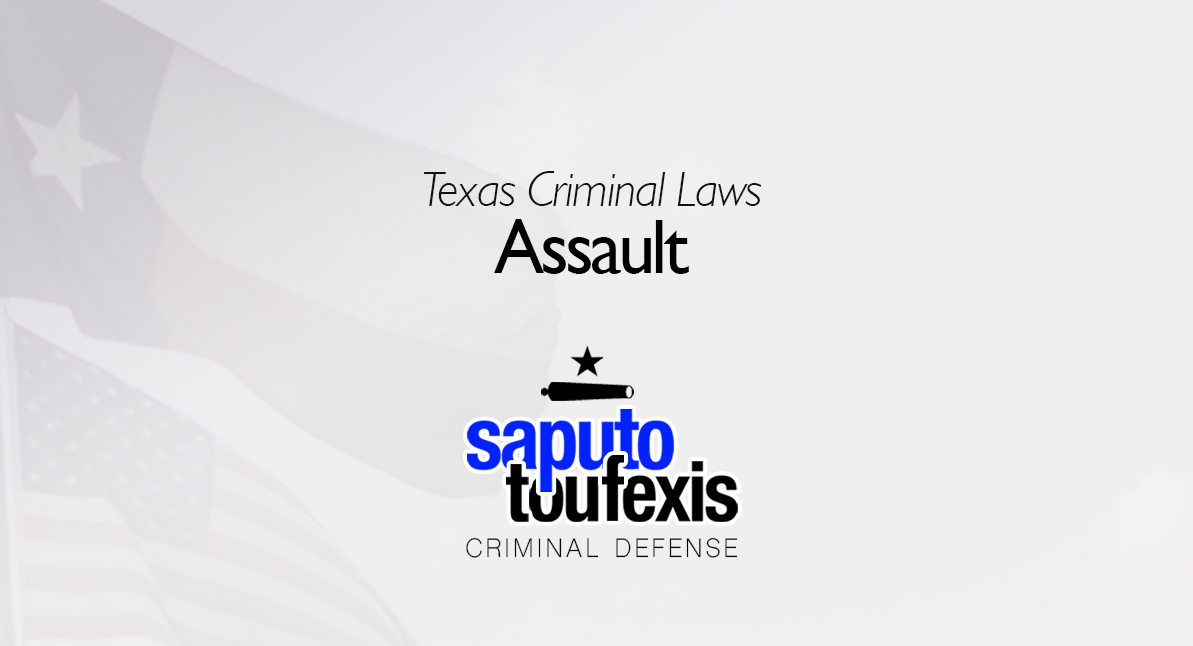The Texas Assault law makes it illegal to cause bodily injury (“Assault – Bodily Injury“), threaten another person (“Assault by Threat“) or cause “offensive contact” (“Assault – Offensive Contact“).
FAQs about the
Assault law in Texas
- What is the current Texas law about Assault?
- What does reckless mean according to the Texas Penal Code?
- What is the law for self-defense in Texas?
- What is the law for defense of third persons in Texas?
- Can you use the defense of protection of life or health, protection of property or any other defenses?
- What is the difference between Simple Assault, Aggravated Assault and Assault with a Deadly Weapon?
- What is the statute of limitation for Assault in Texas?
- What is the penalty for a Texas Assault offense?
- Can you get probation for Assault in Texas?
- What level of crime is Assault in Texas?
An Assault – Bodily Injury charge requires the state to prove that you caused an injury intentionally, knowingly or recklessly. Both Assault by Threat and Assault – Offensive Contact require the state to prove that you acted intentionally or knowingly – reckless actions are not criminal under the Texas Assault law unless they caused bodily injury.
Have you been charged with Assault? Contact us today to discuss legal representation.
or Text or Call (888) 239-9305
Prosecutors can charge you with Assault – Family Violence if an Assault victim was (or had been) in some kind of familial, relationship, or living arrangment with the accused person.
The Texas legislature codified the Assault offense in Texas Penal Code Section 22.01. The Assault law in Texas has been updated by nine different bills in the Texas legislature since 2017, with signifcant changes in each session. All of the changes related to punishment enhancements, enabling the state to seek more significant penalties when the offense involved certain victims. In its 2023 regular session, the legislature created a new enhancement for any victims who are employed by or work in a hospital. Then, in a third special session in 2023, the legislature created another new felony enhancement, effective February 4, 2024, that applies to Assault committed in the course of committing a Human Smuggling offense.
In addition, the Legislature has created new criminal offenses related to Assault in other statutes, such as Indecent Assault. Other assault-related charges in Texas include Sexual Assault, Intoxication Assault, Aggravated Assault, Aggravated Sexual Assault and Injury to a Child.
The Penal Code classifies the Texas Assault law under Title 5 “Offenses Against The Person,” Chapter 22 “Assaultive Offenses.” Learn more about the Texas offense of Assault below.
What is the current Texas law about Assault?
Texas law currently defines the offense of Assault in Penal Code Section §22.01 as follows:[1]
(a) A person commits an offense if the person:
(1) intentionally, knowingly, or recklessly causes bodily injury to another, including the person’s spouse;
(2) intentionally or knowingly threatens another with imminent bodily injury, including the person’s spouse; or
(3) intentionally or knowingly causes physical contact with another when the person knows or should reasonably believe that the other will regard the contact as offensive or provocative.
Both the Assault offense described in subsection (a)(2) (Assault by Threat) and the Assault offense described in subsection (a)(3) (Assault – Offensive Contact) are punished less severely than the subsection (a)(1) Assault – Bodily Injury offense, assuming no enhancements apply). Both Assault by Threat and Assault – Offensive Contact are classified as Class C misdemeanors, unless one of the enhancements apply.
What changed in 2017
In 2017, the legislature created enhancements for Assault by Threat, Assault – Offensive Contact, and Assault – Bodily Injury for assaults against a pregnant individual “to force the individual to have an abortion.”[2] Given that there is now an identical enhancement for assaults against pregnant women generally, this 2017 enhancement does not seem as useful anymore. The new law does require knowledge of the pregnancy, whereas there is no requirement in the old law for the state to prove knowledge of the pregnancy, but it isn’t very likely that anyone would be forcing women who were *not* pregnant to have an abortion. So, any offenses meeting the old enhancement criteria would now fall under the new enhancement.
The 85th Legislature also created an enhancement for assaults on employees and contractors of the Texas Civil Commitment Office by people who are civilly committed.
The third enhancement created in 2017 was the Peace Officer and Judge Enhancement.
What changed in 2019
In 2019, the legislature created an Assault – Bodily Injury enhancement for assaults against pregnant people when the assailant knew that the victim was pregnant.[3]
What changed in 2021
The Process Server Enhancement for Assault – Bodily Injury was created in 2021.[4]
What changed in 2023
The legislature created the Hospital Personnel Enhancement for Assault – Bodily Injuryin 2023.[5] In SB 1179, the 88th Legislature also clarified the Civil Commitment Office enhancement in subsection (b-1) and what offenses count as priors for the purposes of the Family Violence Enhancement under subsection (b)(2)(A) through HB 1589.
What changed in 2024
In a third special session in 2023, the legislature created a new penalty enhancement for Assault committed in the course of committing a Human Smuggling offense.[6] Effective February 4, 2024, this would enhance the offense to a third degree felony.[7]
What does reckless mean according to the Texas Penal Code?
The word “reckless” is defined in Texas Penal Code §6.03 as “disregarding a substantial and unjustifiable risk that the result will occur.” The state’s attorney has to prove recklessness to a jury. The attorney will usually ask the jury to use its “common sense” in determining whether a particular behavior was reckless. A defense attorney can challenge the state attorney’s assertion that an action was reckless.
The Third District Court of Appeals summarized the case law about recklessness as follows:[8]
Conscious disregard of the risk created by the actor’s conduct is at the heart of reckless conduct. … Mere lack of foresight, stupidity, irresponsibility, thoughtlessness, or ordinary carelessness are insufficient; the defendant must “actually foresee the risk involved and consciously decide to ignore it.” … “Those who are subjectively aware of a significant danger to life and choose, without justification, to engage in actions (or in some cases inactions) that threaten to bring about that danger have made a calculated decision to gamble with other people’s lives.” … The defendant, however, “need not be aware of the specific risk of another’s death in order to commit manslaughter.” …. A “combination of an awareness of the magnitude of the risk and the conscious disregard for consequences is crucial.”
What is the law for self-defense in Texas?
Self-defense is a justification for committing Assault if the force (meaning physical force or assault) is used when and to the degree you reasonably believe the force is immediately necessary to protect you against another person’s use or attempted use of unlawful force.[9] Self-defense is considered a justification as opposed to a defense under the Penal Code. There are a number of limitations that apply to the self-defense justification.[10] But Texas law explicitly states that a person is not required to retreat before using force in self-defense, so long as the person had a right to be present at the location where the force is used, had not provoked the person against whom the force is used, and was not engaged in criminal activity at the time the force is used.[11]
What is the law for defense of third persons in Texas?
Texas law also provides a defense to prosecution called the Defense of Third Persons justification. In Texas, you are justified in using force or deadly force against another to protect a third person if:[12]
(1) under the circumstances as the actor reasonably believes them to be, the actor would be justified under Section 9.31 [the non-deadly force self-defense rules] or 9.32 [the deadly force self-defense rules] in using force or deadly force to protect himself against the unlawful force or unlawful deadly force he reasonably believes to be threatening the third person he seeks to protect; and
(2) the actor reasonably believes that his intervention is immediately necessary to protect the third person.
Can you use the defense of protection of life or health, protection of property or any other defenses?
Protection of Life or Health
The Penal Code provides a defense for situations in which you are attempting to protect a person from harming themselves:[13]
(a) A person is justified in using force, but not deadly force, against another when and to the degree he reasonably believes the force is immediately necessary to prevent the other from committing suicide or inflicting serious bodily injury to himself.
(b) A person is justified in using both force and deadly force against another when and to the degree he reasonably believes the force or deadly force is immediately necessary to preserve the other’s life in an emergency.
Protection of Property
Perhaps the most controversial defense is the Protection of Property Defense, where you can justify the use of force to protect your property or someone else’s property. In Texas you can use force to protect your property or someone else’s property – even deadly force, depending on the situation.[14] Texas is a stand your ground state. But be careful with this defense. The Fifth District Court of Appeals in Dallas, Texas, developed some case law regarding the procedural requirements for using the defense of property justification. In Newman v. Texas, the Fifth District Court of Appeals heard an appeal from Michael Dewayne Newman based on the fact that the trial court refused to instruct the jury on the justification of defense of property.
Newman thought that someone was attempting to burglarize his apartment. He confronted the individual, and during the confrontation, Newman saw another person on the balcony of his apartment. Apparently Newman recognized this person on the balcony as a friend of the neighbor that he was already engaging with. Newman thought that he might be working together to steal from him, so he reacting by shooting a gun in the direction of the person on the balcony. However, during trial, Newman denied all of these facts.
The court opined that a justification defense “does not negate any element of the offense, including the culpable intent; it only excuses what would otherwise constitute criminal conduct.” This has the effect of placing a defendant who feels he or she was justified in using force in the unfortunate situation of having to admit to the underlying criminal act. Unfortunately for Newman, the court ruled that his conduct could not be excused through the use of a justification defense and at the same time claim that he did not commit the crime.
Other Types of Defenses
Sometimes assault charges can arise in cases of mistaken identity. A common scenario that we see here would be a bar fight in which a victim is injured, and the victim knows they were assaulted, but they identify the wrong person. In defending our clients against assault charges, we conduct a thorough and independent investigation into the facts of the case and regularly subpoena records and interview witnesses.
There are also certain specific defenses under state law, including Consent and Inapplicability to Certain Conduct
What is the difference between Simple Assault, Aggravated Assault and Assault with a Deadly Weapon?
Simple Assault is defined in Section 22.01 of the Texas Penal Code and requires either bodily injury, offensive contact or a threat of imminent harm. The punishment level of a Simple Assault charge ranges from a Class C misdemeanor to a second degree felony.
Aggravated Assault requires the state to prove either a serious bodily injury or the use of a deadly weapon. The Penal Code classifies Aggravated Assault as a second degree felony by default, but it can be enhanced to a felony of the first degree under certain circumstances.
Assault with a Deadly Weapon is a type of Aggravated Assault where the assailant also used or “exhibited a deadly weapon during the commission of the assault.”
What is the statute of limitation for Assault in Texas?
Any family violence assault carries a minimum three year limitations period, even for misdemeanor offenses.[15] Otherwise, misdemeanor level Assault charges have a two-year limitations period.[16] And felony-level offenses have a three-year limitations period.[17]
What is the penalty for a Texas Assault offense?
The punishment for an Assault charge depends on the offense level for the specific type of Assault offense and whether any enhancements apply.
Assault by Threat and Assault – Offensive Contact
Assault by Threat and Assault – Offensive Contact start at the Class C misdemeanor level (no jail time and a maximum fine of $500). However, each of these charges can be enhanced to the Class B misdemeanor level if the state can prove that the victim was a sports participant (and the assailant was not a participant).[18] Assault – Offensive Contact can be enhanced to a Class A misdemeanor when it is committed against an elderly person.[19] And, as of 2017, both Assault – Offensive Contact and Assault by Threat can be enhanced to the Class A misdemeanor level if the offense was “committed against a pregnant individual to force the individual to have an abortion.”[20]
Assault – Bodily Injury
Assault – Bodily Injury starts as a Class A misdemeanor[21] but can be enhanced to a felony-level offense under a number of different scenarios.
The Public Servant Enhancement
Assault – Bodily Injury can be punished as a third degree felony if the assault was committed against a public servant while the public servant is lawfully discharging an official duty, or in retaliation or on account of an exercise of official power or performance of an official duty as a public servant, so long as the assailant knew the victim was a public servant.[22]
The Family Violence Enhancements
Assault – Bodily Injury can be punished as a third degree felony if the assault was committed against a person with whom you have a dating or familial type relationship[23] (Assault – Family Violence) and either (1) you have a prior conviction for Assault – Family Violence (or related family violence offense[24]);[25] or (2) the allegation is that the assault involved contact with the throat, neck or mouth (the “Impeding” charge).[26] An Assault – Family Violence charge can be enhanced to a second degree felony if you have prior Assault – Family Violence (or related family violence) convictions and the current allegation is that the assault involved contact with the throat, neck or mouth of the victim.[27]
Enhancements for Certain Victims
The Assault – Bodily Injury charge can also be enhanced to a third degree felony if the assault is proven to be committed against a government contractor, security officer, emergency responder, or process server.[28]
The Abortion by Force Enhancement
Effective as of September 2017, a new Assault – Bodily Injury enhancement will apply if the state’s lawyers convince a jury beyond a reasonable doubt that you assaulted a pregnant individual “to force the individual to have an abortion,” making the offense punishable as a third degree felony.[29] The same bill enhanced Class C Assault by Threat and Assault – Offensive Contact to Class A misdemeaors if committed against pregnant women with the same intent.
The Pregnant Victim Enhancement
Effective in 2019, Assault – Bodily Injury can be enhanced for assaults against people you know to be pregnant at the time of the offense.[30]
The Hospital Personnel Enhancement
Effective in 2023, Assault – Bodily Injury is punished as a Third Degree Felony for assaults on people who are employed by or work in a hospital, while in hospitla property, if the assailant knew they were hospital employees.[31]
The Civil Commitment Enhancement
Assault – Bodily Injury is punished as. a Third Degree Felony for assaults by inmates at a civil commitment facility against employees and contractors of the Texas Civil Commitment Office.[32]
The Peace Officer & Judge Enhancement
This enhancement makes an Assault – Bodily Injury conviction a second degree felony “if the offense is committed against a person the actor knows is a peace officer or judge while the officer or judge is lawfully discharging an official duty or in retaliation or on account of an exercise of official power or performance of an official duty as a peace officer or judge.”[33]
The Human Smuggling Enhancement
Effective beginning in 2024, this new third degree felony enhancement applies to Assault committed in the course of committing a Human Smuggling offense.[34]
Can you get probation for Assault in Texas?
The Texas Code of Criminal Procedure allows both judges and juries to grant probation for Assault, and judges are also allowed to accept deferred adjudication plea deals.[35]
Note, however, that no matter the offense, neither judges nor juries may recommend community supervision for any suspended sentence of over 10 years.[36] Also, judges may not grant community supervision after a conviction if (1) the defendant used or exhibited a deadly weapon during the commission of the felony or immediate flight thereafter and (2) the defendant used or exhibited the deadly weapon himself or was a party to the offense and knew that a deadly weapon would be used or exhibited.[37]
What level of crime is Assault in Texas?
The Penal Code classifies the punishment for Assault as a Class A misdemeanor, second degree felony, or third degree felony, depending on the circumstances.
Learn more about the penalty range for this offense in the section above.
Legal References:
^1. Texas Penal Code §22.01. This law is current as of 2024.^2. HB 2552, 85th Texas Legislature (RS), Section 18^3. HB 902, 86th Texas Legislature (RS), Section 1^4. SB 1306, 87th Legislature (RS)^5. SB 840, 88th Legislature (RS)^6. Texas Penal Code §22.01(b-4), as amended by SB 4, 88th Texas Legislature (SS-3), Section 6^7. Texas Penal Code §22.01(b-4)^8. Sanchez v. State, No. 03-22-00199-CR, 2024 Tex. App. LEXIS 2644 (Tex. App. Austin Apr. 17, 2024, no pet. h.)^9. Texas Penal Code §9.31(a)^10. Texas Penal Code §9.31(b) and (d)^11. Texas Penal Code §9.31(e). Texas Penal Code §9.32 provides more specific rules apply to the use of deadly force in self-defense, and Texas Penal Code §9.31(c) provides more specific rules related to the use of force to resist an arrest or search.^12 See §9.33 of the Texas Penal Code^13. Section 9.34 of the Texas Penal Code^14. §9.41 addresses the use of non-deadly force used to protect your own property, and §9.42 addresses the use of deadly force used to protect your own property. §9.43 addresses the use of deadly and non-deadly force used to protect others’ property.^15. Code of Criminal Procedure 12.02(b)^16. Code of Criminal Procedure 12.02(a)^17. See Code of Criminal Procedure 12.01(9)^18. Penal Code Section 22.01(c)(2)^19. Penal Code Section 22.01(c)(1)^20. Penal Code Section 22.01(c)(3), as enacted by HB 2552, 85th Texas Legislature (RS), Section 18, effective September 1, 2017^21. Penal Code Section 22.01(b)^22. Texas Penal Code §22.01(b)(1)^23. The relationship must be as described in Texas Penal Code §22.01(b)(2) – “a person whose relationship to or association with the defendant is described by Section 71.0021(b), 71.003, or 71.005, Family Code.”^24. Under Texas Penal Code §22.01(b)(2)(A)(ii), the prior family violence offense can be any Chapter 19 (Assaultive Offenses) offense, or a violation of Penal Code §20.03 (Kidnapping), §20.04 (Aggravated Kidnapping), §21.11 (Indecency With a Child), §25.11 (Continuous Violence Against the Family), §25.07 (Violation of Certain Court Orders or Conditions of Bond in a Family Violence, Sexual Assault or Abuse, Stalking, or Trafficking Case), if the applicable violation was based on the commission of family violence as described by Subsection (a)(1) of that section, or §25.072 (Repeated Violation of Certain Court Orders or Conditions of Bond in Family Violence, Sexual Assault or Abuse, Stalking, or Trafficking Case), if any of the applicable violations were based on the commission of family violence as described by Section 25.07(a)(1)^25. Texas Penal Code §22.01(b)(2)(A)^26. Texas Penal Code §22.01(b)(2)(B)^27. Texas Penal Code Section 22.01(b-3)^28. Texas Penal Code §22.01(b)(3)-(6) –
(3) a person who contracts with government to perform a service in a facility as defined by Section 1.07(a)(14), Penal Code, or Section 51.02(13) or (14), Family Code, or an employee of that person:
(A) while the person or employee is engaged in performing a service within the scope of the contract, if the actor knows the person or employee is authorized by government to provide the service; or
(B) in retaliation for or on account of the person’s or employee’s performance of a service within the scope of the contract;
(4) a person the actor knows is a security officer while the officer is performing a duty as a security officer;
(5) a person the actor knows is emergency services personnel while the person is providing emergency services;
(6) a person the actor knows is a process server while the person is performing a duty as a process server;
^29. Penal Code §22.01(b)(7), enacted by H.B. 2552, 85th Texas Legislature (RS), Section 18, effective September 1, 2017 (enacted as subsection (b)(6) and later renumbered)^30. Penal Code §22.01(b)(8), enacted by HB 902, 86th Texas Legislature (RS), Section 1, effective September 1, 2019^31. Penal Code §22.01(b)(9), enacted by SB 840, 88th Texas Legislature (RS), Sections 2 &3, effective September 1, 2023^32. Texas Penal Code §22.01(b-1), as enacted by SB 1576, 85th Texas Legislature (RS), Section 27, effective September 1, 2017^33. Texas Penal Code §22.01(b-3), as enacted by HB 2908, 85th Texas Legislature, Section 3, effective September 1, 2017^34. Texas Penal Code §22.01(b-4), as amended by SB 4, 88th Texas Legislature (SS-3), Section 6^35. See Chapter 42, Texas Code of Criminal Procedure, Art. 42A.054, Art. 42A.056, Art. 42A.102 .^36. Art. 42A.053(c), Texas Code of Criminal Procedure^37. Art. 42A.054(b), Texas Code of Criminal Procedure










